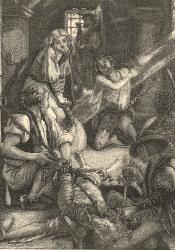Poets of the Nineteenth Century Published
Poets of the Nineteenth Century, one of the most beautiful of all Victorian gift books, was also one of the first to feature the new style of illustration introduced by Pre-Raphaelite artists. The book was conceived and executed by the Brothers Dalziel, a large wood-engraving firm that dominated the illustration market until the end of the century. The Dalziels hired the Reverend Robert Aris Willmott to select poems from 1771-1856 and commissioned 18 artists to produce 100 illustrations for the anthology. Pre-Raphaelite artists included Ford Madox Brown, Arthur Hughes, and John Everett Millais. The featured image shows F. M. Brown's wood-engraved illustration for Lord Byron's "The Prisoner of Chillon," which dramatically focuses on a foreshortened corpse and the agony of a shackled prisoner in the cell. As befitted a costly gift, the book's 400 pages were edged with gilt and enclosed in a decorative cover with a design stamped in gold. In contrast to the contemporaneous Poems, Illustrated, by Alfred Tennyson (aka "The Moxon Tennyson"), Poets of the Nineteenth Century was an immediate commercial and critical success. It sold out its first two editions of 5000 and 3000 copies within a year—an almost unimaginable print run for poetry publishing today—and was reissued multiple times in the following decades. Although dated 1857, it was actually brought out in October 1856, in time for the annual Christmas market when "guinea gift books" were more likely to be purchased by middle-class consumers looking to purchase an attractive present for display on the drawing-room table. This type of “forward dating” allowed publishers to bring the book out as “new” for two consecutive Christmas seasons.
Source: Lorraine Janzen Kooistra, Poetry, Pictures, and Popular Publishing: The Illustrated Gift Book and Victorian Visual Culture 1855-1875

